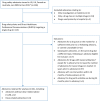Influence of drug safety advisories on drug utilisation: an international interrupted time series and meta-analysis
- PMID: 35058332
- PMCID: PMC8899478
- DOI: 10.1136/bmjqs-2021-013910
Influence of drug safety advisories on drug utilisation: an international interrupted time series and meta-analysis
Abstract
Objective: To evaluate the association between regulatory drug safety advisories and changes in drug utilisation.
Design: We conducted controlled, interrupted times series analyses with administrative prescription claims data to estimate changes in drug utilisation following advisories. We used random-effects meta-analysis with inverse-variance weighting to estimate the average postadvisory change in drug utilisation across advisories.
Study population: We included advisories issued in Canada, Denmark, the UK and the USA during 2009-2015, mainly concerning drugs in common use in primary care. We excluded advisories related to over-the-counter drugs, drug-drug interactions, vaccines, drugs used primarily in hospital and advisories with co-interventions within ±6 months.
Main outcome measures: Change in drug utilisation, defined as actual versus predicted percentage change in the number of prescriptions (for advisories without dose-related advice), or in the number of defined daily doses (for dose-related advisories), per 100 000 population.
Results: Among advisories without dose-related advice (n=20), the average change in drug utilisation was -5.83% (95% CI -10.93 to -0.73; p=0.03). Advisories with dose-related advice (n=4) were not associated with a statistically significant change in drug utilisation (-1.93%; 95% CI -17.10 to 13.23; p=0.80). In a post hoc subgroup analysis of advisories without dose-related advice, we observed no statistically significant difference between the change in drug utilisation following advisories with explicit prescribing advice, such as a recommendation to consider the risk of a drug when prescribing, and the change in drug utilisation following advisories without such advice.
Conclusions: Among safety advisories issued on a wide range of drugs during 2009-2015 in 4 countries (Canada, Denmark, the UK and the USA), the association of advisories with changes in drug utilisation was variable, and the average association was modest.
Keywords: health policy; health services research; medication safety; pharmacoepidemiology.
© Author(s) (or their employer(s)) 2022. Re-use permitted under CC BY-NC. No commercial re-use. See rights and permissions. Published by BMJ.
Conflict of interest statement
Competing interests: MLDB declares PhD grants from Novo Nordisk, Lundbeck, Ferring Pharmaceuticals and LEO Pharma to the Copenhagen Centre for Regulatory Science; CH declares grants or contracts from Novo Nordisk A/S and H. Lundbeck A/S paid to her institution; BM is acting as an expert witness for Health Canada on a legal case and anticipates future payment for doing so; S-AP declares the Centre for Big Data Research in Health received funding for postmarket surveillance research, unrelated to the current study; LP has received a Michael Smith Foundation for Health Research Reach Grant; AS declares grants or contracts from Arnold Ventures and the FDA paid to his institution, consulting fees from West Health and payment for expert testimony from the ACLU; IS has received a CIHR Canadian Network for Observational Drug Effect Studies grant and a Drug Evaluation Alliance of Nova Scotia grant, and payment for serving as a member of the Patented Medicine Prices Review Board.
Figures



References
Publication types
MeSH terms
Grants and funding
LinkOut - more resources
Full Text Sources
